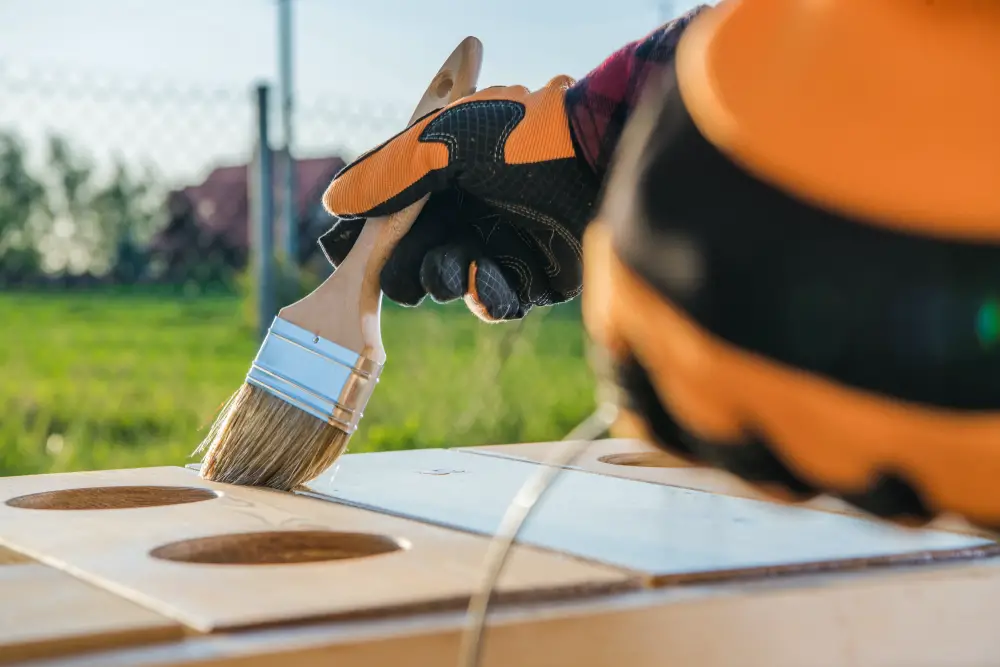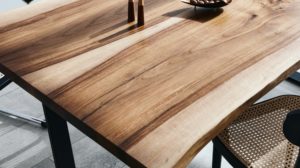Waxing and oiling wood does not always mean natural wood. Indeed, they're used a lot on uncolored wood, because they bring out the natural design of the wood and its specific colors. But there are also those who want colored wood, even if they finish it with oil and wax. You will say that wax and oil are natural and the colors are for modern finishes. And aren't the colors also natural? The raw green of the forest, the red of the poppy, the gray of weathered wood, the purple of lavender, the yellow of the sunflower are colors of nature that look great on furniture or wooden decorative objects. There are several ways of staining wood finished with oil or wax, and pigmentation is one of them. One natural, multi-colored option is Kreidezeit range of pigments.

Wax and oil are increasingly used as finishing options
Before pigmentation, let's talk a bit about oil finishing and wax. Unlike wax, which is used more as a top coat or for furniture maintenance, oil is used to protect wood, both inside and out. It has the ability to go deep into the wood and protect it from the inside. As oil and water do not get along, it is also used for protecting wood used outdoors, thus preventing the risk of rotting due to rain or snow.
But be careful, colorless oil only protects wood against water. The problem is that the sun, especially UV radiation, is an equally important enemy of wood. To be fully protected outdoors, the oil used must be colored. A pigment content of 3-5% will give the oil a slight colored tint, but the finish will remain transparent. That small amount of pigment will sit in the path of the sun, deflecting its rays and reducing their destructive effect. The higher the pigment content, the higher the level of protection, with paints providing better protection than lacquers (which are semi-transparent). A big advantage of finishing exterior wood with oil-based products is the ease of maintenance and refinishing. Over time, weathering will wash off the oil and the wood will slowly take on a dry look. This is when you need to apply another coat of the product you are using (tincture or oil-based paint), without sanding to completely remove the old coating. If the color remains, but the wet look disappears, you can even use a colorless oil to "feed" the paint or varnish again.
Why are wax and oil used to finish furniture or wooden objects? For the natural look. Unlike traditional varnishes, which leave a film, wax and oil do not leave a visible coating on top. The grain of the wood is pleasant and the sheen is slightly silky, like that of gelled wood. All this gives warmth to the wood, which is transferred to the space in which we find the objects or furniture. The lack of an obvious film does not mean that the wood is not protected. The chemical and mechanical resistances are lower than those of hardened varnishes, for example, but are comparable to those of shellac or nitro lacquer. If the finish is done correctly, the oil and wax will not stain your clothes and the surface will not become sticky.
What do I do if I want the wood stained?
How can I stain wood? Can I use water-based stain if I am going to use oil or wax? How do I color wax and oil? Which do I apply first, the water-based stain or the oil? Can I apply colored varnish over wax? How can I change the color of oiled furniture? These are just some of the questions received in the comments box. Coloring can be done in different ways to achieve different effects. For example, if I color the wood and then apply colorless oil or wax, the wood's design will be very noticeable and the finish will be transparent. If I use colored oil, I will get a more uniform look, but lose the transparency. Each time it must be very clear what we want to achieve in the end in order to use the right materials and methods.
When finishing with oil or wax, the wood may be stained beforehand or stained oil or wax may be applied directly. When staining is done beforehand, both solvent-based and water-based stains can be used, provided they are simple stains without added resins or other substances that could lead to later incompatibilities. In general, water-based stains are more deeply absorbed into the wood, which brings out the wood's design better, and have brighter colors. Solvent-based stains are duller and give a more uniform appearance. Whatever type of stain, the surface should be allowed to dry thoroughly before applying oil or wax.
Staining can also be done directly, using colored wax or oil. The advantage of this method is that, depending on the wood used, special effects can be achieved. For example, on a wood with large pores and specific pattern - oak, frasin - The colored wax will highlight the pores resulting in a very pleasant effect. Also, if the wood has not been well sanded after sawing, the circular marks will be highlighted by the colored wax, giving a rustic effect.
Outstanding furniture looks can be achieved by using the right colors, oil, wax or pigments. Remember, the finish helps you to get something special out of ordinary wood, but equally, if not done well, it can make a special wood lose its beauty altogether.

A solution for lots of shades and colors - Kreidezeit pigments
Pigments are the solution to get any color you want. In the trade there are usually the classic colors - walnut, oak, mahogany, wenge - because they are the most widely used. If you want a more special color, you can look for companies that make colors according to known color charts (RAL, NCS) or can copy them, but it's difficult unless you need a large quantity. It is very difficult to reproduce a color when the quantity is small, especially if the color is light. But you can make your own colors using Kreidezeit pigments.
Kreidezeit pigments - a range containing 22 pigments that can be mixed with each other - are natural, in powder form, contain no added chemicals or other auxiliaries and very importantly, no heavy metals. They can be used for coloring oils, waxes, glazes, varnishes, plasters or wall paints. They can be used without problems to color toys or children's furniture. Unlike colorants, which dissolve in water, pigments form dispersions with water. In the case of Kreidezeit pigments, mixing with water is easy and does not form lumps. They can also be used for coloring solvent-based products.
I used Kreidezeit pigments and was amazed at how well and easily they mixed with the oil. I expected it to be very hard to get paint from pigment and oil. I had in mind the paint scrubbing machines of the old days, which worked for hours to get the paint to be even, with no clumps of pigment. Now all I had to do was put the pigment in a small amount of oil and stir with a chopstick. The pigment blended quickly and didn't clump. I then diluted with the rest of the oil to get to the percentage I needed (20% pigment, for paints). I got a uniform color that I could use right away.
Mixing with wax is a little harder because it is solid, but not impossible. You can heat the wax to make it more fluid, but do not exceed the recommended percentage of pigment. Too much pigment does not embed in the wax and after application, the pigment will easily rub off on clothes or hands. The amount should not exceed 20-25%, regardless of the material with which the pigment is mixed. To obtain semitransparent lacquers (used to protect wood outdoors), the percentage of pigment is between 3 and 5%.
I hope you will be able to achieve the colors you want using the Kreidezeit range of pigments. And don't forget, the pigments can be mixed with each other, so you can get an infinite number of shades and colors.



































Hello, what could I use to remove resin drips and drips from wood without discoloring or burning it before oiling?
Hello!
With white spirit (petrosin), turpentine oil, alcohol or universal thinner.
The problem is that if there are pockets of resin in the wood, the resin will continue to flow after the oil is applied. In factories, the resin bags are removed and replaced with wooden 'sticks'. The resin dripping knots can be sealed with shellac before the wood is oiled.
All the best!